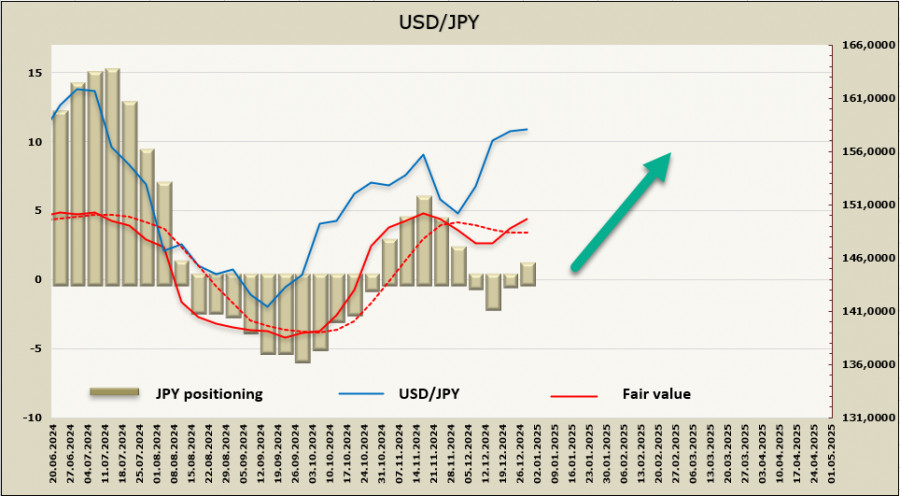यह भी देखें


 10.01.2025 12:38 AM
10.01.2025 12:38 AMMacroeconomic data from Japan presents a mixed picture, leaving the outlook for the yen uncertain.
Consumer sentiment deteriorated in December, with data from the Cabinet Office showing a decline in the index from 36.4 to 36.2. Additionally, the output gap in Japan, which measures the difference between actual and potential production, has remained negative for the 18th consecutive quarter. This indicates that actual output is below full capacity, suggesting insufficient demand. These disappointing figures imply that the Bank of Japan may adopt a wait-and-see approach at its upcoming meeting on January 24, potentially delaying a rate hike. Such a decision would likely be negative for the yen, resulting in further weakening of the currency.
At the same time, base wages rose by 2.7% in November, with nominal wages increasing by 3% year-on-year, marking the highest annual growth in 32 years. However, due to high inflation, real incomes fell by 0.3%, with inflation outpacing wage growth for the fourth consecutive month. These figures call for a rate hike. It's worth noting that the previous rate hike occurred after members of Japan's largest trade union federation, Rengo, secured the highest wage increase in three decades. This factor is considered perhaps the most critical, after inflation, in the debate over rate hikes. Rengo will release its next report on March 14, aiming for a wage increase of at least 5%, a goal the government is actively resisting. Union positions are strong—the labor share of income, expressed as the ratio of total wages to GDP, has been steadily declining since 2021.
Will the BOJ wait for Rengo's report, or will it act sooner? If the Bank chooses to wait, the January 24 meeting is likely to conclude without any significant decisions, which could lead to a continued weakening of the yen. Conversely, if the BOJ decides to raise rates ahead of the report, the yen may strengthen considerably.
Opinions on this issue are divided, and the outcome remains uncertain. In December, BOJ Governor Ueda indicated that trends in wage negotiations could become apparent even before Rengo's official tally in March, suggesting that the Bank might act sooner. But how soon could that be—January or early March? Since the yen has not yet shown signs of breaking its negative trend, investors remain skeptical that the balance of opinion is shifting toward a decision in January. The release of December's Consumer Price Index (CPI), scheduled just hours before the January 24 meeting, could play a decisive role in this scenario. However, with two weeks remaining before this release and no major news expected in the interim, uncertainty persists.
For traders focusing on the yen, the most straightforward strategy is to practice patience and trade within a sideways range. Any hint or statement from the government, the BOJ, or labor unions will be closely examined. Additionally, a significant event in January is Donald Trump's inauguration, which could offer insights into his new economic and trade policies and whether they will be as inflationary as the markets currently anticipate.
Positioning on the yen remains neutral; investors are uncertain about its direction and have reduced their activity while waiting for new data. The calculated price has risen above the long-term average, indicating potential for a move upward.
The dollar exhibits a clear bullish sentiment, allowing the USD/JPY pair to reach a six-month high. However, growth remains cautious due to conflicting macroeconomic data that does not provide a clear picture. We anticipate that trading will continue within a sideways range, with potential minor movements towards the 161.96 high.
You have already liked this post today
*यहां पर लिखा गया बाजार विश्लेषण आपकी जागरूकता बढ़ाने के लिए किया है, लेकिन व्यापार करने के लिए निर्देश देने के लिए नहीं |
बाजारों में एक नई उत्साह की लहर दौड़ पड़ी है। कई लोग मानते हैं कि यह संयोग नहीं है: किसी व्यक्ति से सब कुछ छीन लो और फिर उसे थोड़ी
ट्रेनिंग वीडियो

Your IP address shows that you are currently located in the USA. If you are a resident of the United States, you are prohibited from using the services of InstaFintech Group including online trading, online transfers, deposit/withdrawal of funds, etc.
If you think you are seeing this message by mistake and your location is not the US, kindly proceed to the website. Otherwise, you must leave the website in order to comply with government restrictions.
Why does your IP address show your location as the USA?
Please confirm whether you are a US resident or not by clicking the relevant button below. If you choose the wrong option, being a US resident, you will not be able to open an account with InstaTrade anyway.
We are sorry for any inconvenience caused by this message.


